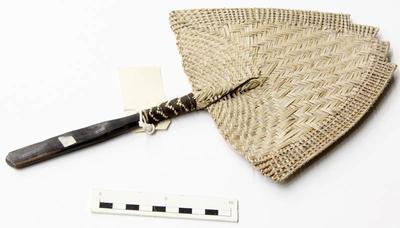Fan
Description
Iliili, fan, most likely made from coconut leaf midrib and pandanus leaf strips, woven into an intricate, radiating pattern. The leaf fibres are secured to the dark wood handle with finely plaited human hair binding, and narrow leaf strips form a chevron pattern.
See full details
Object detail
Production place
Classification
Credit line
This
leaf-shaped
iliili
(fan)
is
one
of
the
treasures
from
Niue
cared
for
at
Puke
Ariki.
It
was
made
in
the
1800s,
and
was
collected
by
English
settler
Adolphus
Kyngdon,
who
had
arrived
in
Taranaki
in
1850
on
the
SS
Eden,
aged
16.
The midrib of coconut leaves, and pandanus leaf strips are used to make iliili, and they are woven into intricate, radiating patterns. The dark wood handle is bound with finely plaited human hair, and narrow leaf strips create a chevron pattern. In nineteenth century Niue, human hair was used for a range of ornaments – girdles made up of hundreds of lengths of finely plaited hair were worn around the waist, and these were known as kafa.
Adolphus Kyngdon collected this fan and other items from the Pacific himself. In April 1894 the Taranaki Herald reported that Mr Kyngdon had just returned from “his tour round the world”. He donated his collection to the Museum in 1901, and this included a collection of Japanese fans, and embroidered shoes from China. He did most of his travels in his 60s and 70s, visiting South Africa, South America, Australia and New Guinea.
Text by Natasha McKinney, 10th August 2022.
References:
Akeli, S. & Pasene, S., 2011. “Exploring ‘the Rock’: Material culture from Niue Island in Te Papa’s Pacific Cultures collection.” Tuhinga 22: 101-124.
Rutherford, J. & Skinner, W.H., (eds.), 1969. The establishment of the New Plymouth Settlement in New Zealand 1841-1843. New Plymouth: Thomas Avery & Sons Ltd.
Taranaki Herald, 21 April 1894, page 2 in section “Chit-Chat: Up to date”.
Taranaki Herald, 29 May 1912, page 7 [Obituary for Adolphus Kyngdon].
The midrib of coconut leaves, and pandanus leaf strips are used to make iliili, and they are woven into intricate, radiating patterns. The dark wood handle is bound with finely plaited human hair, and narrow leaf strips create a chevron pattern. In nineteenth century Niue, human hair was used for a range of ornaments – girdles made up of hundreds of lengths of finely plaited hair were worn around the waist, and these were known as kafa.
Adolphus Kyngdon collected this fan and other items from the Pacific himself. In April 1894 the Taranaki Herald reported that Mr Kyngdon had just returned from “his tour round the world”. He donated his collection to the Museum in 1901, and this included a collection of Japanese fans, and embroidered shoes from China. He did most of his travels in his 60s and 70s, visiting South Africa, South America, Australia and New Guinea.
Text by Natasha McKinney, 10th August 2022.
References:
Akeli, S. & Pasene, S., 2011. “Exploring ‘the Rock’: Material culture from Niue Island in Te Papa’s Pacific Cultures collection.” Tuhinga 22: 101-124.
Rutherford, J. & Skinner, W.H., (eds.), 1969. The establishment of the New Plymouth Settlement in New Zealand 1841-1843. New Plymouth: Thomas Avery & Sons Ltd.
Taranaki Herald, 21 April 1894, page 2 in section “Chit-Chat: Up to date”.
Taranaki Herald, 29 May 1912, page 7 [Obituary for Adolphus Kyngdon].
Accession number
A79.620
Collection type
Material

Public comments
Be the first to comment on this object record.